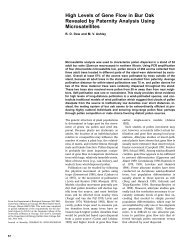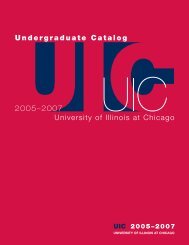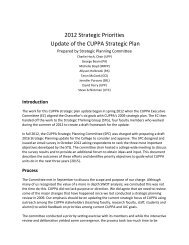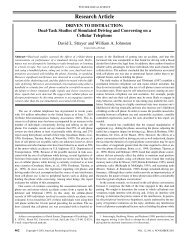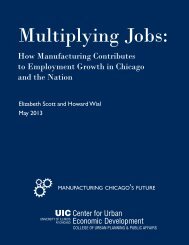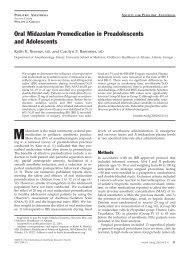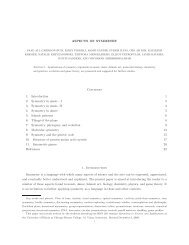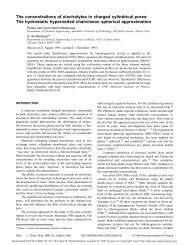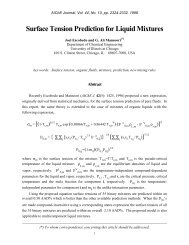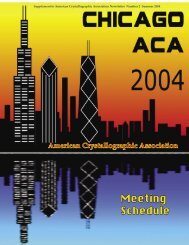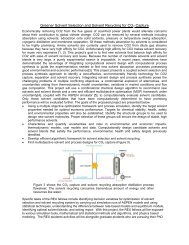Appendix C: - University of Illinois at Chicago
Appendix C: - University of Illinois at Chicago
Appendix C: - University of Illinois at Chicago
You also want an ePaper? Increase the reach of your titles
YUMPU automatically turns print PDFs into web optimized ePapers that Google loves.
consistent, based on a chi-square test, then the deposit on the sample filter can be<br />
considered to be uniform and concentr<strong>at</strong>ions can be extrapol<strong>at</strong>ed with confidence.<br />
Results <strong>of</strong> the chi-square analyses for every project filter on which <strong>at</strong> least one structure<br />
was observed are presented in Table 3A. Results for the quality control samples<br />
analyzed in this study are presented in table 36. In both cases, chrysotile and<br />
amphibole structures were separ<strong>at</strong>ely evalu<strong>at</strong>ed and, in both cases, counts <strong>of</strong> total<br />
structures longer than 5 pm were subjected to the chi square test.<br />
The first columns <strong>of</strong> both Table 3A and 36 indic<strong>at</strong>e the sample identific<strong>at</strong>ion number.<br />
The next two columns indic<strong>at</strong>e, respectively, the test st<strong>at</strong>istic observed for chrysotile<br />
counts from the indic<strong>at</strong>ed sample and whether the counts can be considered to be<br />
consistent (based on a chi square). The fourth and fifth columns in each table indic<strong>at</strong>e<br />
the same inform<strong>at</strong>ion for amphibole structures. Note th<strong>at</strong> the tables are divided into two<br />
halves (to reduce table size) and identical inform<strong>at</strong>ion is presented in each half <strong>of</strong> each<br />
table (for different structures).<br />
Because five grid specimens are being compared, the appropri<strong>at</strong>e critical values for the<br />
chi square test is with four degrees <strong>of</strong> freedom (one less than the number <strong>of</strong><br />
realiz<strong>at</strong>ions <strong>of</strong> the counts evalu<strong>at</strong>ed). The critical value corresponding to a 0.05 level <strong>of</strong><br />
significance for this test (with four degrees <strong>of</strong> freedom) is 9.49. Thus, whenever the test<br />
* st<strong>at</strong>istic is less than 9.49, the filter deposit can be considered to be uniform.<br />
As can be seen in Table 3A, there are 64 sets <strong>of</strong> specimen grids on which <strong>at</strong> least one<br />
structure was observed so th<strong>at</strong> a chi square test was conducted. It can also be seen<br />
* from this table th<strong>at</strong> there are only three out <strong>of</strong> the 64 tests for which the chi square<br />
st<strong>at</strong>istic is larger than the critical value. However, <strong>at</strong> a 0.05 level <strong>of</strong> significance, one<br />
would expect three failures <strong>of</strong> the chi square test (among 64 tries) by chance alone.<br />
Thus, it is reasonable to conclude from the d<strong>at</strong>a presented in Table 3A th<strong>at</strong> sample<br />
filters analyzed in this study are entirely uniform and results can be reasonably<br />
extrapol<strong>at</strong>ed to estim<strong>at</strong>e concentr<strong>at</strong>ions in the sampled m<strong>at</strong>erial.<br />
A similar conclusion can also be drawn from the d<strong>at</strong>a presented in Table 38. Although<br />
two failures among the 24 tests indic<strong>at</strong>ed is slightly higher than the one failure<br />
expected, this small difference is not sufficient to suggest a problem. In fact, we should<br />
also consider th<strong>at</strong> there are more than 1 00 cases in which no chrysotile structures or<br />
(separ<strong>at</strong>ely) no amphibole structures were detected on any <strong>of</strong> the grids in a set and th<strong>at</strong><br />
such cases represent "perfect' agreement with zero counts on each <strong>of</strong> five grid<br />
specimens. Thus, if these cases were to be included, we would expect more than 9<br />
failures overall, while only five failures were observed.<br />
Duplic<strong>at</strong>e and replic<strong>at</strong>e analyses. A series <strong>of</strong> duplic<strong>at</strong>e splits and/or replic<strong>at</strong>e<br />
analyses were also conducted on selected samples to further evalu<strong>at</strong>e the performance<br />
<strong>of</strong> the labor<strong>at</strong>ories particip<strong>at</strong>ing in this study. In some cases, duplic<strong>at</strong>e split samples<br />
were prepared and both pairs were analyzed (blind) by the primary labor<strong>at</strong>ory for the<br />
Pagec3<strong>of</strong> 15<br />
UNITED ANALYTICAL SERVICES, INC.<br />
Page 44



